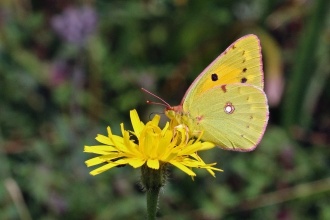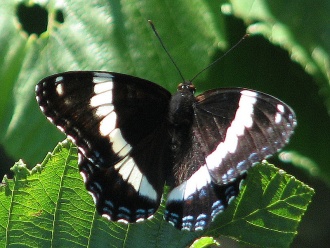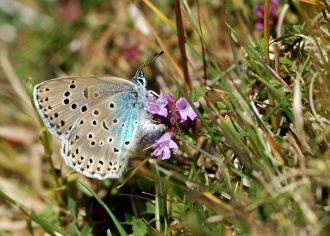This is the last article you can read this month
You can read more article this month
You can read more articles this month
Sorry your limit is up for this month
Reset on:
Please help support the Morning Star by subscribing here
SAT IN my granddaughter’s sunny garden, celebrating her birthday over a glass of squash just a week ago, an amazing thing happened.
A bright yellow butterfly flitted across our table. In minutes it was followed by a large beautiful blue butterfly and the almost immediately by a tiny delicate blue butterfly.
These three flew around for a few minutes while we marvelled at how early in the year it was to see butterflies. Finally a cabbage white bought the amazing aerial ballet to its conclusion.
In the last 20 years over three quarters of Britain’s resident and regular migrant butterfly populations have declined. This is of great concern not just for butterflies but for other wildlife species and the overall state of the environment.
The conservation of Britain’s 59 species of butterflies is an enormous challenge. Of those species 57 are residents and just two — the painted lady and the clouded yellow — are regular migrants.
The painted lady is a long-distance migrant. Each year, it flies from the desert fringes of north Africa, the Middle East, and central Asia to arrive in our gardens.

The clouded yellow comes to Britain from north Africa and southern Europe each May and June. In more recent years, a small number of this species have overwintered in the south of England. In good years clouded yellows can produce up to three generations in Britain.
Five species of butterfly have become extinct in the last century and a half. Just one, the large blue, was successfully reintroduced in 1992.
Mass observations by volunteers working with various butterfly charities show that butterflies with specific habitat requirements as well as wider countryside species are both decreasing significantly.
The wall and small heath now rank among the most severely threatened British butterflies. The destruction and deterioration of habitats as a result of land use change such as industrialised agriculture and changing woodland management are still among key threats.
It isn’t all bad news. Some British butterflies, but only a minority, have fared well since the 1970s. Indeed some have actually increased their distributions.
This may be down to global warming but we must not assume warmer temperatures will bring species from warmer places to live in Britain.
Over the past decade the long-term declines of some threatened species have been halted and small recoveries seen in some areas.
Examples include the duke of Burgundy, pearl-bordered fritillary and dingy skipper.
Dedicated landscape conservation projects making the area perfect for threatened species are very successful and it would be great if more of these initiatives could be rolled out.

Some more threatened populations such as wood white and white admiral show little signs of numbers increasing. Just as worryingly populations of some common species like gatekeeper and Essex skipper have dwindled in recent years.
The butterflies granddaughter Lizzie and I saw fluttering by had only one thing on their mind. Yes, just like Prince Andrew, it is sex. Unlike Randy Andy, they spend a deal of time finding exactly the ideal partner they want to pass on their genes with.
Finding a mate to share their short lives with is their most important mission for them and they don’t have long. Most adult butterflies will live for only one or two weeks, although some species hibernate during the winter and may live several months.
In their short lives nourishment will come mainly from drinking rather than eating solid food. While caterpillars have voracious appetites, as any gardener knows, adult butterflies generally don’t eat much. Because of their straw-like mouthparts they are mainly restricted to a liquid diet.
Butterflies use their proboscis to drink sweet nectar from flowers. They will also eat overripe or even rotting fruit, again mostly sucking up the liquidised parts of the flesh.
Now let us get back to sex. If you are lucky enough to catch a sight of a pair of butterflies actually at it, you will marvel at the beauty and gymnastic delicacy of this aerial ballet.
Male butterflies compete with each other in many different ways to find a suitable female and win her over. They judge her colour and brightness.
Coloured wings aren’t just to make them pretty. They allow the insects to recognise their own species. Colours also distinguish between males and females — vital when you are looking for a partner.
The butterfly wings absorb certain wavelengths of light and reflect others, causing the eye to see bright iridescent colour. Some species have wings that are made up of millions of tiny scales. The scales reflect light waves, creating very intense shimmering colours.
The Victorians killed millions of butterflies to use these iridescent scales to decorate picture frames, jewellery and even furniture. A hundred years on these antiques can be just as bright today.
As well as vision, butterflies also use sound and chemical signalling to find a mate. Both males and females release powerful pheromones to attract the right partner. Some female hormones are so powerful that a male butterfly can sense them 10 miles away.
Male butterflies searching for a mate can get overexcited when seeking a partner. They chase after almost any small, moving object like leaves, bees and butterflies of any species — of either sex.
The males start working out if they’ve found the right match by judging colours, pheromones and behaviour. Once a pair of potential lovers has found each other the courtship can start. In many species, the female requires the male to perform a dance to size him up before she will allow him near.
Males are frequently rejected by picky partners. Only the luckiest butterflies are successful on the first attempt. He delicately flies around her, whirring his wings to waft his pheromones in her direction.
If she is impressed enough to accept, she will change her posture, letting her abdomen protrude from between her wings. He then joins the end of his abdomen with the end of hers and transfers his sperm. She will use it to fertilise many eggs.
Actual mating is only the start of a further long and complicated process called metamorphosis to produce new generations of adults.
There are four stages in the metamorphosis of butterflies: egg, larva, pupa and adult.

The female lays her fertilised eggs, often on carefully selected plants that become food for the hatching caterpillars.
Depending on species, eggs can be laid from spring, summer or autumn. Females lay lots of tiny eggs. Only some will survive and hatch to the next stage — the caterpillar.
Caterpillars are the larval stage and their only job is to eat as much as possible while avoiding getting eaten themselves. There is nothing in a caterpillar that tells you it’s going to be a butterfly.
They eat so much that their skin splits. It may split up to four or five times. An egg the size of a pinhead can grow into a caterpillar two inches long in several weeks. When the caterpillar is full-grown and stops eating, it becomes a pupa. We usually call them a chrysalis.
Depending on the species, the chrysalis may hide under a branch, among leaves or bury itself underground. This stage can last from a few weeks, a month or even longer. Some species have a pupal stage that lasts for two years.
Cells inside the chrysalis will become the legs, wings, eyes and other parts of the adult butterfly. Other larva cells will provide energy for these growing adult cells.
Eventually the chrysalis will burst. Out will creep the fully formed, but very damp and creased adult. It will usually pull itself onto a plant stem where it can dry its wings in the sunshine.
Once dry it can fly off to look for a mate, fluttering across our paths to lift our spirits on its way.
Butterflies play crucial roles in the food chain, as well as being pollinators of plants. That is why restoring butterfly populations across Britain, in gardens, urban green spaces and the countryside, will bring substantial benefits to innumerable other species and also to the health, wealth and wellbeing of the human population.
I don’t know about you, but the sight of a butterfly — or four — will always bring a smile to my face. Better still if it’s on my granddaughter’s birthday.










